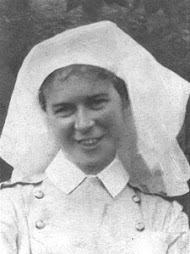Remembering Those Women Lost in Afghanistan
in Our Own Era
Today I want to begin by recognizing that Canada has lost its third female soldier in combat in Afghanistan. The first two were Captain Nicola Goddard of Calgary, who died on May 17, 2006, and Trooper Karine Blais, who died in April 2009. Both were performing combat roles. The most recent woman to die in the line of duty in Afghanistan was playing the role most connected with the women who died overseas during the First World War. Master Cpl. Kristal Giesebrecht was a medic from Canadian Forces Base Petawawa. She was 34 years old when she died. At the time of her death (June 27, 2010), Geisbrecht and Pte. Andrew Miller and other troops were responding to a call for help from an Afghan family whose home had been rigged by the Taliban with explosives. Enroute, the medics' armoured vehicle struck a makeshift landmine and they were both killed. Seven medics have now died in Afghanistan. According to Matthew Fisher of Canwest News Services, "Although largely unheralded, medical technicians have one of the most dangerous and important trades in the military. They routinely go forward with infantry and combat engineers into the most perilous areas." This seems to me to be an apt description of the military nurses who also died in the First World War and I thought it would be appropriate today to recognize the fact that such women are continuing in that role today.
Remembering Great War Nurse Henrietta Mellett
Canadian Nursing Sister Henrietta Mellett was the last nursing sister to be killed by enemy action during the Great War. She was on board the Irish mail-boat, HMS Leinster, when it was attacked by the German submarine UB-123 and struck by torpedoes on October 10, 1918. The ship was in the Irish Sea at the time. Five-hundred and one people were killed in the attack. The ship took only 13 minutes to sink.
According to an article by Marc Leroux of the Canadian Great War Project, Henrietta Mellett was born in Galway, Ireland October 21, 1883, and enlisted with the Canadian Army Medical Corps (No 15 General Hospital) at London, England on January 22, 1918. She likely immigrated to Canada sometime prior to 1911 and it may have been that her family had moved from Galway to Dublin and was living there in 1918. For that reason, she may have been returning to England on October 10, 1918 after visiting them. Her body was recovered and is buried in Dublin.
Henrietta's attestation papers reveal that her next of kin was her sister "Mrs. Bowen of 218 St. George St. London, Ontario. (See Annette Fulford's comment on this). Henrietta was Anglican. Before she signed on with the CAMC she had already served 18 months in Egypt with the Red Cross and 10 months with the Red Cross in Tumbridge Wells, Kent. This would have been extremely demanding work under difficult conditions. Like many Canadian nursing sisters, she may not have initially been able to sign on with the CAMC at the beginning of the war (many women wanted to enlist, but there was a limited number of openings), but joined later in the war after serving with a different nursing service.
Those interested in the sinking of the Leinster may also want to read "Torpedoed! The RMS Leinster Disaster by Philip Lecane.
Subscribe to:
Post Comments (Atom)






















Debbie, Henrietta Mellett is listed in the 1911 Canadian census as a nurse at Victoria Hospital in London, Ontario. The year of immigration is listed as 1909, but I found her arriving in Canada on the Empress of Britain in August 1908 with Rev Richard Bowen and his wife Susan. They were headed to London, Ontario.
ReplyDelete